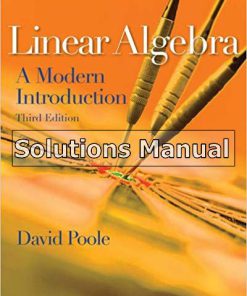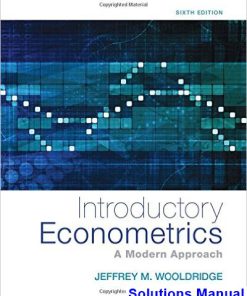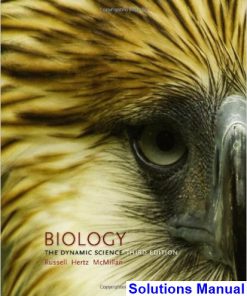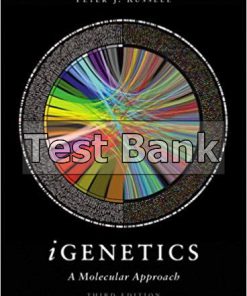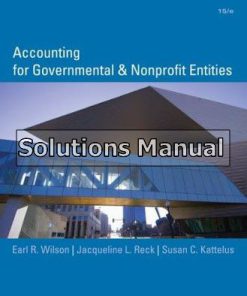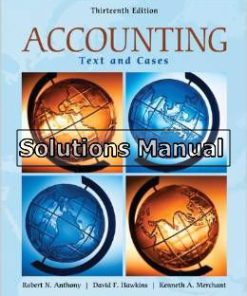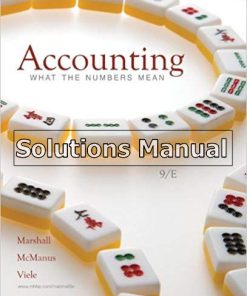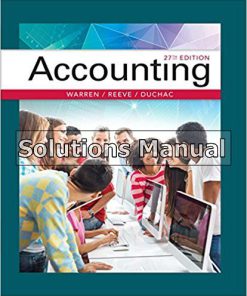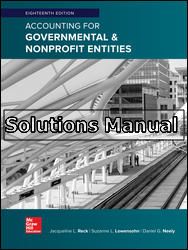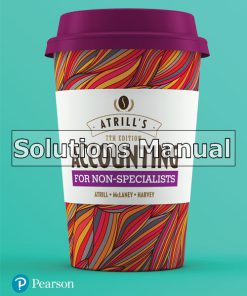Artificial Intelligence A Modern Approach 3rd Edition Russell Solutions Manual
$26.50$50.00 (-47%)
Artificial Intelligence A Modern Approach 3rd Edition Russell Solutions Manual.
You may also like
Artificial Intelligence A Modern Approach 3rd Edition Russell Solutions Manual
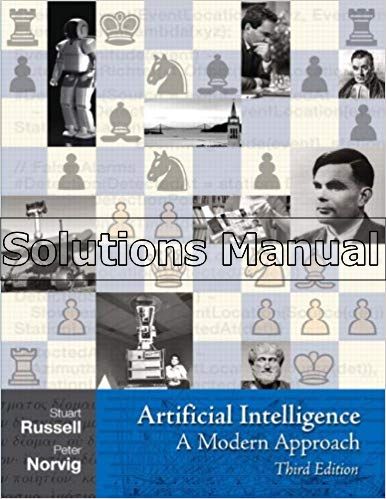
Product details:
- ISBN-10 : 0136042597
- ISBN-13 : 978-0136042594
- Author: Stuart Russell
Artificial Intelligence: A Modern Approach, 3e offers the most comprehensive, up-to-date introduction to the theory and practice of artificial intelligence. Number one in its field, this textbook is ideal for one or two-semester, undergraduate or graduate-level courses in Artificial Intelligence.
Dr. Peter Norvig, contributing Artificial Intelligence author and Professor Sebastian Thrun, a Pearson author are offering a free online course at Stanford University on artificial intelligence.
Table contents:
I Artificial Intelligence
1 Introduction
1.1 What is AI? . . . . . . . . . . . . . . . . . . . . . . . . . . . . . . . . . 1
1.2 The Foundations of Artificial Intelligence . . . . . . . . . . . . . . . . . . 5
1.3 The History of Artificial Intelligence . . . . . . . . . . . . . . . . . . . . 16
1.4 The State of the Art . . . . . . . . . . . . . . . . . . . . . . . . . . . . . 28
1.5 Summary, Bibliographical and Historical Notes, Exercises . . . . . . . . . 29
2 Intelligent Agents
2.1 Agents and Environments . . . . . . . . . . . . . . . . . . . . . . . . . . 34
2.2 Good Behavior: The Concept of Rationality . . . . . . . . . . . . . . . . 36
2.3 The Nature of Environments . . . . . . . . . . . . . . . . . . . . . . . . . 40
2.4 The Structure of Agents . . . . . . . . . . . . . . . . . . . . . . . . . . . 46
2.5 Summary, Bibliographical and Historical Notes, Exercises . . . . . . . . . 59
II Problem-solving
3 Solving Problems by Searching
3.1 Problem-Solving Agents . . . . . . . . . . . . . . . . . . . . . . . . . . . 64
3.2 Example Problems . . . . . . . . . . . . . . . . . . . . . . . . . . . . . . 69
3.3 Searching for Solutions . . . . . . . . . . . . . . . . . . . . . . . . . . . 75
3.4 Uninformed Search Strategies . . . . . . . . . . . . . . . . . . . . . . . . 81
3.5 Informed (Heuristic) Search Strategies . . . . . . . . . . . . . . . . . . . 92
3.6 Heuristic Functions . . . . . . . . . . . . . . . . . . . . . . . . . . . . . 102
3.7 Summary, Bibliographical and Historical Notes, Exercises . . . . . . . . . 108
4 Beyond Classical Search
4.1 Local Search Algorithms and Optimization Problems . . . . . . . . . . . 120
4.2 Local Search in Continuous Spaces . . . . . . . . . . . . . . . . . . . . . 129
4.3 Searching with Nondeterministic Actions . . . . . . . . . . . . . . . . . . 133
4.4 Searching with Partial Observations . . . . . . . . . . . . . . . . . . . . . 138
4.5 Online Search Agents and Unknown Environments . . . . . . . . . . . . 147
4.6 Summary, Bibliographical and Historical Notes, Exercises . . . . . . . . . 153
5 Adversarial Search
5.1 Games . . . . . . . . . . . . . . . . . . . . . . . . . . . . . . . . . . . . 161
5.2 Optimal Decisions in Games . . . . . . . . . . . . . . . . . . . . . . . . 163
5.3 Alpha—Beta Pruning . . . . . . . . . . . . . . . . . . . . . . . . . . . . . 167
5.4 Imperfect Real-Time Decisions . . . . . . . . . . . . . . . . . . . . . . . 171
5.5 Stochastic Games . . . . . . . . . . . . . . . . . . . . . . . . . . . . . . 177
5.6 Partially Observable Games . . . . . . . . . . . . . . . . . . . . . . . . . 180
5.7 State-of-the-Art Game Programs . . . . . . . . . . . . . . . . . . . . . . 185
5.8 Alternative Approaches . . . . . . . . . . . . . . . . . . . . . . . . . . . 187
5.9 Summary, Bibliographical and Historical Notes, Exercises . . . . . . . . . 189
6 Constraint Satisfaction Problems
6.1 Defining Constraint Satisfaction Problems . . . . . . . . . . . . . . . . . 202
6.2 Constraint Propagation: Inference in CSPs . . . . . . . . . . . . . . . . . 208
6.3 Backtracking Search for CSPs . . . . . . . . . . . . . . . . . . . . . . . . 214
6.4 Local Search for CSPs . . . . . . . . . . . . . . . . . . . . . . . . . . . . 220
6.5 The Structure of Problems . . . . . . . . . . . . . . . . . . . . . . . . . . 222
6.6 Summary, Bibliographical and Historical Notes, Exercises . . . . . . . . . 227
III Knowledge, Reasoning, and Planning
7 Logical Agents
7.1 Knowledge-Based Agents . . . . . . . . . . . . . . . . . . . . . . . . . . 235
7.2 The Wumpus World . . . . . . . . . . . . . . . . . . . . . . . . . . . . . 236
7.3 Logic . . . . . . . . . . . . . . . . . . . . . . . . . . . . . . . . . . . . . 240
7.4 Propositional Logic: A Very Simple Logic . . . . . . . . . . . . . . . . . 243
7.5 Propositional Theorem Proving . . . . . . . . . . . . . . . . . . . . . . . 249
7.6 Effective Propositional Model Checking . . . . . . . . . . . . . . . . . . 259
7.7 Agents Based on Propositional Logic . . . . . . . . . . . . . . . . . . . . 265
7.8 Summary, Bibliographical and Historical Notes, Exercises . . . . . . . . . 274
8 First-Order Logic
8.1 Representation Revisited . . . . . . . . . . . . . . . . . . . . . . . . . . 285
8.2 Syntax and Semantics of First-Order Logic . . . . . . . . . . . . . . . . . 290
8.3 Using First-Order Logic . . . . . . . . . . . . . . . . . . . . . . . . . . . 300
8.4 Knowledge Engineering in First-Order Logic . . . . . . . . . . . . . . . . 307
8.5 Summary, Bibliographical and Historical Notes, Exercises . . . . . . . . . 313
9 Inference in First-Order Logic
9.1 Propositional vs. First-Order Inference . . . . . . . . . . . . . . . . . . . 322
9.2 Unification and Lifting . . . . . . . . . . . . . . . . . . . . . . . . . . . 325
9.3 Forward Chaining . . . . . . . . . . . . . . . . . . . . . . . . . . . . . . 330
9.4 Backward Chaining . . . . . . . . . . . . . . . . . . . . . . . . . . . . . 337
9.5 Resolution . . . . . . . . . . . . . . . . . . . . . . . . . . . . . . . . . . 345
9.6 Summary, Bibliographical and Historical Notes, Exercises . . . . . . . . . 357
10 Classical Planning
10.1 Definition of Classical Planning . . . . . . . . . . . . . . . . . . . . . . . 366
10.2 Algorithms for Planning as State-Space Search . . . . . . . . . . . . . . . 373
10.3 Planning Graphs . . . . . . . . . . . . . . . . . . . . . . . . . . . . . . . 379
10.4 Other Classical Planning Approaches . . . . . . . . . . . . . . . . . . . . 387
10.5 Analysis of Planning Approaches . . . . . . . . . . . . . . . . . . . . . . 392
10.6 Summary, Bibliographical and Historical Notes, Exercises . . . . . . . . . 393
11 Planning and Acting in the Real World
11.1 Time, Schedules, and Resources . . . . . . . . . . . . . . . . . . . . . . . 401
11.2 Hierarchical Planning . . . . . . . . . . . . . . . . . . . . . . . . . . . . 406
11.3 Planning and Acting in Nondeterministic Domains . . . . . . . . . . . . . 415
11.4 Multiagent Planning . . . . . . . . . . . . . . . . . . . . . . . . . . . . . 425
11.5 Summary, Bibliographical and Historical Notes, Exercises . . . . . . . . . 430
12 Knowledge Representation
12.1 Ontological Engineering . . . . . . . . . . . . . . . . . . . . . . . . . . . 437
12.2 Categories and Objects . . . . . . . . . . . . . . . . . . . . . . . . . . . 440
12.3 Events . . . . . . . . . . . . . . . . . . . . . . . . . . . . . . . . . . . . 446
12.4 Mental Events and Mental Objects . . . . . . . . . . . . . . . . . . . . . 450
12.5 Reasoning Systems for Categories . . . . . . . . . . . . . . . . . . . . . 453
12.6 Reasoning with Default Information . . . . . . . . . . . . . . . . . . . . 458
12.7 The Internet Shopping World . . . . . . . . . . . . . . . . . . . . . . . . 462
12.8 Summary, Bibliographical and Historical Notes, Exercises . . . . . . . . . 467
IV Uncertain Knowledge and Reasoning
13 Quantifying Uncertainty
13.1 Acting under Uncertainty . . . . . . . . . . . . . . . . . . . . . . . . . . 480
13.2 Basic Probability Notation . . . . . . . . . . . . . . . . . . . . . . . . . . 483
13.3 Inference Using Full Joint Distributions . . . . . . . . . . . . . . . . . . . 490
13.4 Independence . . . . . . . . . . . . . . . . . . . . . . . . . . . . . . . . 494
13.5 Bayes’ Rule and Its Use . . . . . . . . . . . . . . . . . . . . . . . . . . . 495
13.6 The Wumpus World Revisited . . . . . . . . . . . . . . . . . . . . . . . . 499
13.7 Summary, Bibliographical and Historical Notes, Exercises . . . . . . . . . 503
14 Probabilistic Reasoning
14.1 Representing Knowledge in an Uncertain Domain . . . . . . . . . . . . . 510
14.2 The Semantics of Bayesian Networks . . . . . . . . . . . . . . . . . . . . 513
14.3 Efficient Representation of Conditional Distributions . . . . . . . . . . . . 518
14.4 Exact Inference in Bayesian Networks . . . . . . . . . . . . . . . . . . . 522
14.5 Approximate Inference in Bayesian Networks . . . . . . . . . . . . . . . 530
14.6 Relational and First-Order Probability Models . . . . . . . . . . . . . . . 539
14.7 Other Approaches to Uncertain Reasoning . . . . . . . . . . . . . . . . . 546
14.8 Summary, Bibliographical and Historical Notes, Exercises . . . . . . . . . 551
15 Probabilistic Reasoning over Time
15.1 Time and Uncertainty . . . . . . . . . . . . . . . . . . . . . . . . . . . . 566
15.2 Inference in Temporal Models . . . . . . . . . . . . . . . . . . . . . . . . 570
15.3 Hidden Markov Models . . . . . . . . . . . . . . . . . . . . . . . . . . . 578
15.4 Kalman Filters . . . . . . . . . . . . . . . . . . . . . . . . . . . . . . . . 584
15.5 Dynamic Bayesian Networks . . . . . . . . . . . . . . . . . . . . . . . . 590
15.6 Keeping Track of Many Objects . . . . . . . . . . . . . . . . . . . . . . . 599
15.7 Summary, Bibliographical and Historical Notes, Exercises . . . . . . . . . 603
16 Making Simple Decisions
16.1 Combining Beliefs and Desires under Uncertainty . . . . . . . . . . . . . 610
16.2 The Basis of Utility Theory . . . . . . . . . . . . . . . . . . . . . . . . . 611
16.3 Utility Functions . . . . . . . . . . . . . . . . . . . . . . . . . . . . . . . 615
16.4 Multiattribute Utility Functions . . . . . . . . . . . . . . . . . . . . . . . 622
16.5 Decision Networks . . . . . . . . . . . . . . . . . . . . . . . . . . . . . . 626
16.6 The Value of Information . . . . . . . . . . . . . . . . . . . . . . . . . . 628
16.7 Decision-Theoretic Expert Systems . . . . . . . . . . . . . . . . . . . . . 633
16.8 Summary, Bibliographical and Historical Notes, Exercises . . . . . . . . . 636
17 Making Complex Decisions
17.1 Sequential Decision Problems . . . . . . . . . . . . . . . . . . . . . . . . 645
17.2 Value Iteration . . . . . . . . . . . . . . . . . . . . . . . . . . . . . . . . 652
17.3 Policy Iteration . . . . . . . . . . . . . . . . . . . . . . . . . . . . . . . . 656
17.4 Partially Observable MDPs . . . . . . . . . . . . . . . . . . . . . . . . . 658
17.5 Decisions with Multiple Agents: Game Theory . . . . . . . . . . . . . . . 666
17.6 Mechanism Design . . . . . . . . . . . . . . . . . . . . . . . . . . . . . 679
17.7 Summary, Bibliographical and Historical Notes, Exercises . . . . . . . . . 684
V Learning
18 Learning from Examples
18.1 Forms of Learning . . . . . . . . . . . . . . . . . . . . . . . . . . . . . . 693
18.2 Supervised Learning . . . . . . . . . . . . . . . . . . . . . . . . . . . . . 695
18.3 Learning Decision Trees . . . . . . . . . . . . . . . . . . . . . . . . . . . 697
18.4 Evaluating and Choosing the Best Hypothesis . . . . . . . . . . . . . . . 708
18.5 The Theory of Learning . . . . . . . . . . . . . . . . . . . . . . . . . . . 713
18.6 Regression and Classification with Linear Models . . . . . . . . . . . . . 717
18.7 Artificial Neural Networks . . . . . . . . . . . . . . . . . . . . . . . . . 727
18.8 Nonparametric Models . . . . . . . . . . . . . . . . . . . . . . . . . . . 737
18.9 Support Vector Machines . . . . . . . . . . . . . . . . . . . . . . . . . . 744
18.10 Ensemble Learning . . . . . . . . . . . . . . . . . . . . . . . . . . . . . 748
18.11 Practical Machine Learning . . . . . . . . . . . . . . . . . . . . . . . . . 753
18.12 Summary, Bibliographical and Historical Notes, Exercises . . . . . . . . . 757
19 Knowledge in Learning
19.1 A Logical Formulation of Learning . . . . . . . . . . . . . . . . . . . . . 768
19.2 Knowledge in Learning . . . . . . . . . . . . . . . . . . . . . . . . . . . 777
19.3 Explanation-Based Learning . . . . . . . . . . . . . . . . . . . . . . . . 780
19.4 Learning Using Relevance Information . . . . . . . . . . . . . . . . . . . 784
19.5 Inductive Logic Programming . . . . . . . . . . . . . . . . . . . . . . . . 788
19.6 Summary, Bibliographical and Historical Notes, Exercises . . . . . . . . . 797
20 Learning Probabilistic Models
20.1 Statistical Learning . . . . . . . . . . . . . . . . . . . . . . . . . . . . . 802
20.2 Learning with Complete Data . . . . . . . . . . . . . . . . . . . . . . . . 806
20.3 Learning with Hidden Variables: The EM Algorithm . . . . . . . . . . . . 816
20.4 Summary, Bibliographical and Historical Notes, Exercises . . . . . . . . . 825
21 Reinforcement Learning
21.1 Introduction . . . . . . . . . . . . . . . . . . . . . . . . . . . . . . . . . 830
21.2 Passive Reinforcement Learning . . . . . . . . . . . . . . . . . . . . . . 832
21.3 Active Reinforcement Learning . . . . . . . . . . . . . . . . . . . . . . . 839
21.4 Generalization in Reinforcement Learning . . . . . . . . . . . . . . . . . 845
21.5 Policy Search . . . . . . . . . . . . . . . . . . . . . . . . . . . . . . . . 848
21.6 Applications of Reinforcement Learning . . . . . . . . . . . . . . . . . . 850
21.7 Summary, Bibliographical and Historical Notes, Exercises . . . . . . . . . 853
VI Communicating, Perceiving, and Acting
22 Natural Language Processing
22.1 Language Models . . . . . . . . . . . . . . . . . . . . . . . . . . . . . . 860
22.2 Text Classification . . . . . . . . . . . . . . . . . . . . . . . . . . . . . . 865
22.3 Information Retrieval . . . . . . . . . . . . . . . . . . . . . . . . . . . . 867
22.4 Information Extraction . . . . . . . . . . . . . . . . . . . . . . . . . . . . 873
22.5 Summary, Bibliographical and Historical Notes, Exercises . . . . . . . . . 882
23 Natural Language for Communication
23.1 Phrase Structure Grammars . . . . . . . . . . . . . . . . . . . . . . . . . 888
23.2 Syntactic Analysis (Parsing) . . . . . . . . . . . . . . . . . . . . . . . . . 892
23.3 Augmented Grammars and Semantic Interpretation . . . . . . . . . . . . 897
23.4 Machine Translation . . . . . . . . . . . . . . . . . . . . . . . . . . . . . 907
23.5 Speech Recognition . . . . . . . . . . . . . . . . . . . . . . . . . . . . . 912
23.6 Summary, Bibliographical and Historical Notes, Exercises . . . . . . . . . 918
24 Perception
24.1 Image Formation . . . . . . . . . . . . . . . . . . . . . . . . . . . . . . . 929
24.2 Early Image-Processing Operations . . . . . . . . . . . . . . . . . . . . . 935
24.3 Object Recognition by Appearance . . . . . . . . . . . . . . . . . . . . . 942
24.4 Reconstructing the 3D World . . . . . . . . . . . . . . . . . . . . . . . . 947
24.5 Object Recognition from Structural Information . . . . . . . . . . . . . . 957
24.6 Using Vision . . . . . . . . . . . . . . . . . . . . . . . . . . . . . . . . . 961
24.7 Summary, Bibliographical and Historical Notes, Exercises . . . . . . . . . 965
25 Robotics
25.1 Introduction . . . . . . . . . . . . . . . . . . . . . . . . . . . . . . . . . 971
25.2 Robot Hardware . . . . . . . . . . . . . . . . . . . . . . . . . . . . . . . 973
25.3 Robotic Perception . . . . . . . . . . . . . . . . . . . . . . . . . . . . . . 978
25.4 Planning to Move . . . . . . . . . . . . . . . . . . . . . . . . . . . . . . 986
25.5 Planning Uncertain Movements . . . . . . . . . . . . . . . . . . . . . . . 993
25.6 Moving . . . . . . . . . . . . . . . . . . . . . . . . . . . . . . . . . . . . 997
25.7 Robotic Software Architectures . . . . . . . . . . . . . . . . . . . . . . . 1003
25.8 Application Domains . . . . . . . . . . . . . . . . . . . . . . . . . . . . 1006
25.9 Summary, Bibliographical and Historical Notes, Exercises . . . . . . . . . 1010
VII Conclusions
26 Philosophical Foundations
26.1 Weak AI: Can Machines Act Intelligently? . . . . . . . . . . . . . . . . . 1020
26.2 Strong AI: Can Machines Really Think? . . . . . . . . . . . . . . . . . . 1026
26.3 The Ethics and Risks of Developing Artificial Intelligence . . . . . . . . . 1034
26.4 Summary, Bibliographical and Historical Notes, Exercises . . . . . . . . . 1040
27 AI: The Present and Future 1044
27.1 Agent Components . . . . . . . . . . . . . . . . . . . . . . . . . . . . . 1044
27.2 Agent Architectures . . . . . . . . . . . . . . . . . . . . . . . . . . . . . 1047
27.3 Are We Going in the Right Direction? . . . . . . . . . . . . . . . . . . . 1049
27.4 What If AI Does Succeed? . . . . . . . . . . . . . . . . . . . . . . . . . 1051
A Mathematical Background
A.1 Complexity Analysis and O() Notation . . . . . . . . . . . . . . . . . . . 1053
A.2 Vectors, Matrices, and Linear Algebra . . . . . . . . . . . . . . . . . . . 1055
A.3 Probability Distributions . . . . . . . . . . . . . . . . . . . . . . . . . . . 1057
B Notes on Languages and Algorithms
B.1 Defining Languages with Backus—Naur Form (BNF) . . . . . . . . . . . . 1060
B.2 Describing Algorithms with Pseudocode . . . . . . . . . . . . . . . . . . 1061
B.3 Online Help . . . . . . . . . . . . . . . . . . . . . . . . . . . . . . . . . 1062
Bibliography 1063
Index 1095
People also search:
artificial intelligence a modern approach 3rd edition solutions
artificial intelligence a modern approach 3rd edition pdf reddit
artificial intelligence a modern approach 3rd used
solution manual artificial intelligence a modern approach 3rd edition
artificial intelligence a modern approach 3rd edition ppt

